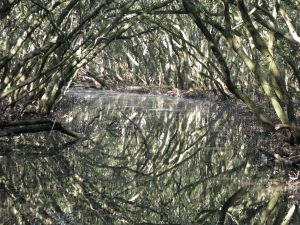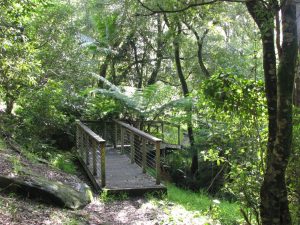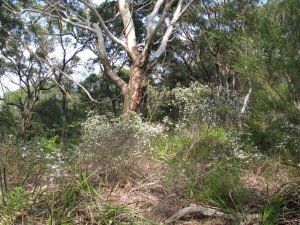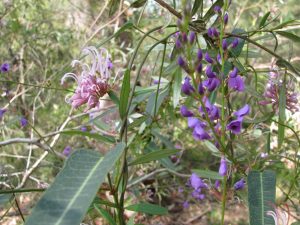Graham Fry from East Hills Group shares his Bushcare experience, responding to a recent call in the APS NSW enewsletter. With wife Liz Cameron, he is also an active member of Oatley Flora and Fauna Conservation Society. He is a recent board member of APS NSW.
Poulton Park, Hurstville
We are bushcarers in Poulton Park, Hurstville, a 20 ha area of bushland and playing fields virtually on our doorstep. Extensive removal of privet and other trees was undertaken in Poulton Park in the 1980s by contract bush regenerators (Matt Allison and his dedicated team) and in 1997 Kogarah Council established a volunteer group to assist the process through weed removal and native plantings. Following council amalgamation, the group now operates under the Georges River Council Bushcare Program.
History
Poulton Park has a chequered history. Parts were used as a dairy and a piggery and in the 1970s the lower section was smothered by dredge spoil from nearby Oatley Bay. Kogarah Council undertook the dredging to deepen anchorage and to get rid of “mosquito breeding habitat such as mangroves, etc”. Local groups including Oatley Flora and Fauna Conservation Society (OFF) fought hard to stop spoil being dumped on Poulton Park but not before a large section was permanently covered and converted to playing fields. OFF members have also undertaken extensive planting of local species at a number of council reserves in the St George area.


How it works
Our group meets for a 3-hour morning session twice a month and we are supervised by a qualified bush regenerator. Georges River Council provides training, protective clothing and implements. Ages range from 30 to 80+, including some from the original 1997 intake. Between five and ten people turn up for each session, which is interrupted by a convivial morning tea break. We enjoy learning to distinguish exotics from native plants at all stages of development, and have become familiar with the indigenous flora of the Park. While Bushcare was suspended during COVID restrictions the two of us could combine exercise in our neighbourhood with weeding and plant spotting. That’s when we noticed an unfamiliar straggly bush with daisy flowers – Olearia viscidula which is unusual in the Georges River area. See article in APS East Hills Group Newsletter October 2021.
The plants
Fortunately about 15 ha of bushland remains – sandstone vegetation (heath and dry sclerophyll woodland) grading at higher elevations to a small area of threatened Sydney Turpentine Ironbark Forest on shale soil. Our Bushcare group focuses on this latter area. Thanks to the hard work of the Bushcare contractors in removing privet and other introduced trees from severely degraded sections (primary clearing), we volunteers can concentrate on weeding and revegetating with plants native to the area.


Supporting bird habitat
We recognise the importance of retaining pockets of dense exotic understorey for small birds. We conduct monthly bird surveys in the Park and enter the data in a national database. Birdlife is still relatively rich in this narrow patch of bush surrounded by houses, but small birds have declined significantly. One cause is the density of aggressive Noisy Miners and an understorey of privet, lantana and asparagus fern provides shelter from them. Removal of further exotics will be judicious until the plantings and natural regeneration have restored structural diversity in the native flora.
Take action
Find out more about your local Council’s Bushcare program and how you can help conserve Australian native plants.
Read about the Bushcare experience of another East Hills Group member, Chris King, here.
